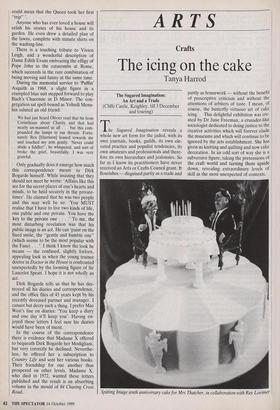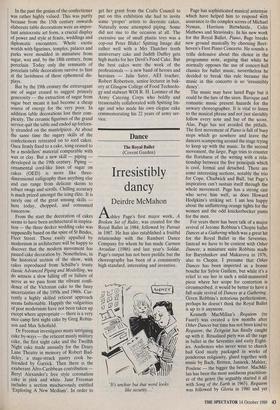ARTS
Crafts
The icing on the cake
Tanya Harrod
The Sugared Imagination: An Art and a Trade (Cliffe Castle, Keighley, till 3 December and touring)
The Sugared Imagination reveals a whole new art form for the jaded, with its own journals, books, guilds, its own ele- vated practice and populist tendencies, its own amateurs and professionals and there- fore its own hierarchies and jealousies. So far as I know its practitioners have never received an Arts or Crafts Council grant. ft flourishes — disguised partly as a trade and partly as housework — without the benefit of prescriptive criticism and without the attentions of arbiters of taste. I mean, of course, the butterfly virtuoso art of cake icing. This delightful exhibition was cre- ated by Dr June Freeman, a crusader-like sociologist dedicated to doing justice to the creative activities which will forever elude the museums and which will continue to be ignored by the arts establishment. She has given us knitting and quilting and now cake decoration. In an odd sort of way she is a subversive figure, taking the pretensions of the craft world and turning them upside down, revealing extraordinary levels of skill in the most unexpected of contexts.
Spitting Image tenth anniversary cake for Mrs Thatcher, in collaboration with Ray Lorimer In the past the genius of the confectioner was rather highly valued. This was partly because from the 15th century onwards elaborate table decorations were an impor- tant aristocratic art form, a crucial display of power and style at feasts, weddings and diplomatic encounters. Whole exotic worlds with figurines, temples, palaces and parks were moulded in miniature from sugar, wax and, by the 18th century, from porcelain. Today only the remnants of porcelain table decorations survive to hint at the lavishness of these ephemeral dis- plays.
But by the 19th century the extravagant use of sugar ceased to suggest princely generosity — the extraction of sugar from sugar beet meant it had become a cheap source of energy for the very poor. In addition table decorations lost their com- plexity. The ceramic figurines of the grand service quit the table and ended up forlorn- ly stranded on the mantelpiece. At about the same time the sugary skills of the confectioners retreated on to iced cakes. Once firmly fixed to a cake, icing ceased to be a modellers' material comparable with wax or clay. But a new skill — piping developed in the 19th century. Piping ornamental cord-like lines of sugar on cakes (OED) is more like three- dimensional calligraphy than anything else and can range from delicate skeins to robust swags and scrolls. Chilling accuracy is much prized amongst the icing elite. It is surely one of the great unsung skills here today, chopped, and consumed tomorrow.
From the start the decoration of cakes seems to have been architectural in inspira- tion — the three decker wedding cake was supposedly based on the spire of St Brides, Fleet Street. Those easily appalled by modernism in architecture will be happy to discover that the modern movement has passed cake decoration by. Nonetheless, in the historical section of the show, with cakes reproduced from Schtilbe's trusty classic Advanced Piping and Modelling, we do witness a slow falling off or failure of nerve as we pass from the vibrant confi- dence of the Victorian cake to the fussy Uncertainties of the 1950s and 1960s. Cur- rently a highly skilled reticent approach seems fashionable. Happily the vulgarities of post modernism have not been taken up except where appropriate — there is a very nice camp first night cake by Greg Robin- son and Max Schofield.
Dr Freeman investigates many intriguing cake by-ways — the reticent manly military cake, the first night cake and the Twelfth Night cake made annually for the Drury Lane Theatre in memory of Robert Bad- deley, a stage-struck pastry cook be- friended by Garrick. Then there is the exuberant Afro-Caribbean contribution - Beryl Alexander's free style coronation cake in pink and white. June Freeman includes a section mischievously entitled `Exploring A New Medium'. In order to get her grant from the Crafts Council to put on this exhibition she had to invite some 'proper' artists to decorate cakes. Naturally none attempted piping. Some did not rise to the occasion at all. The excessive use of small plastic toys was a cop-out Peter Blake! Spitting Image did rather well with a Mrs Thatcher tenth anniversary cake and Judith Duffey gets high marks for her Devil's Food Cake. But the best cakes were the work of the professionals — a new band of heroes and heroines — Julie Suter, AEI teacher, Robert Robertson, senior lecturer in bak- ery at Glasgow College of Food Technolo- gy and stalwart WOI R. H. Lorimer of the Army Catering Corps who boldly and treasonably collaborated with Spitting Im- age and who made his own elegiac cake commemorating his 22 years of army ser- vice.



























































 Previous page
Previous page